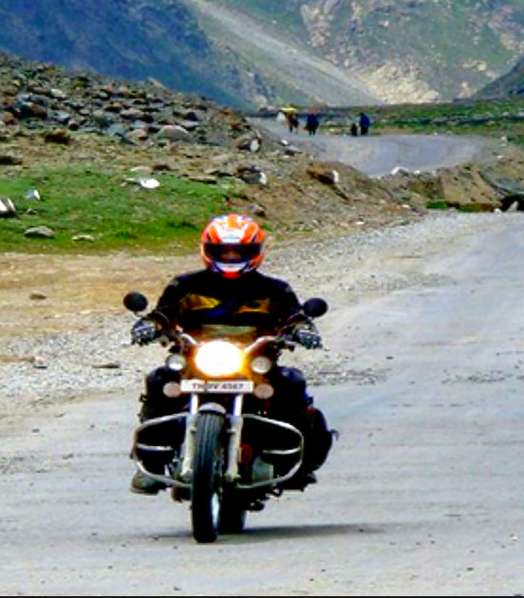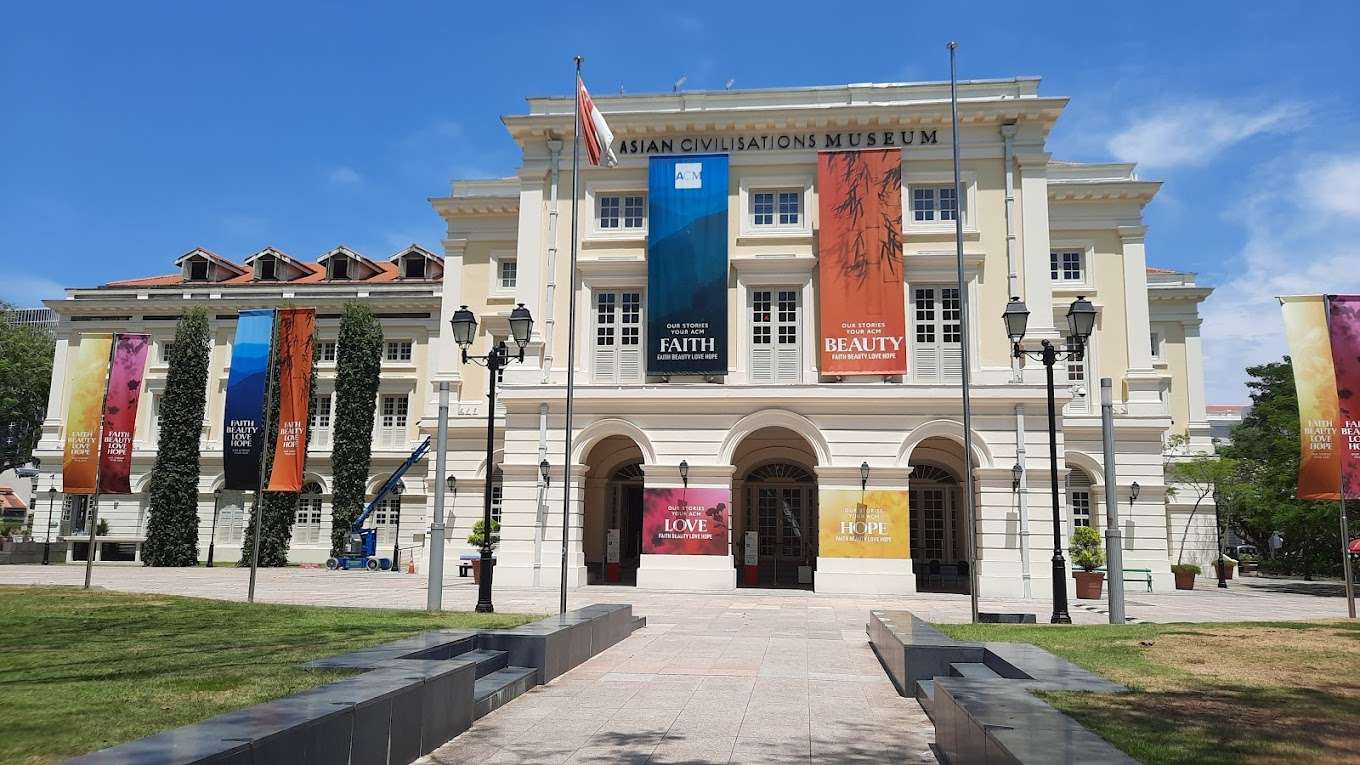About Asian Civilisations Museum
Originally founded in 1997 in the former Tao Nan School Building on Armenian Street, Asian Civilisations Museum is an ode to the diverse heritage and culture of Singapore as well as the rest of the Asian continent.
The museum initially featured 10 galleries comprising displays focused on China and other periodical exhibitions. However, after being relocated to its current location within the walls of Empress Place Building in 2003, the museum now houses several themed exhibitions spread across three levels, making it a must-visit attraction for those seeking Singapore tour packages.
Singapore's best museums comprise four major museums, namely the National Museum of Singapore, Peranakan Museum, Singapore Art Museum, and the Asian Civilisations Museum (ACM). Of these four, ACM specializes in Pan- Asian civilizations and traditions.
Interestingly, Peranakan Museum was once just a special exhibition at the old ACM premise, however, its successful appreciation among visitors led the Board to make it a permanent one, and later it was formed into a separate museum.
The regions vastly covered by ACM consist of Southeast Asia, China, and South and West Asia. The current building that ACM is located in dates back to 1867 when the neoclassical structure served as an office to several government departments.
Must Read: Museums in Singapore
Asian Civilisations Museum Highlights
• Discover a fusion of artistic traditions from across the centuries in thematically arranged galleries.
• You will find more than 1,000 ceramics, gold, and silver pieces originating from the Indian Ocean trade.
• Get to know the major religions of the world and their profound influence on Asian cultures.
• Admire the craftsmanship that demonstrates global, regional, and local exchanges in fashion, jewelry, ceramics, and textiles.
Asian Civilisations Museum Accessibilities
• Wheelchair Accessible
How To Reach Asian Civilisations Museum
By Bus: The Asian Civilisation Museum is located just a 2 minute walk from the Fullerton Bus Stop, hence making it easy for people to reach here. You can easily find a bus from your nearby stop and cover the distance in no time.
Suggested Read: Places to Visit in Singapore with Family
Asian Civilisations Museum Other Essential Information
Tours at Asian Civilisations Museum
1. ACM Treasures in AR: The innovative startup iMMERSiVELY brings treasures from ACM to life using AR. Learn about Asian antiquities and decorative art that span different cultures and showcase the region's rich artistic heritage, including a rare golden cup from the Tang Shipwreck collection, an incense burner embedded with objects from different cultures, and an exquisite bridal headdress.
Using polygon by polygon models (constructed in under 4MB to give the most natural interpretation), viewers can get an up-close view of each masterpiece, offering insight into the richness of cross-cultural contact, as well as an understanding of people's interaction and inspiration over time.
2. Audio Description Tours: Some sighted listeners may find audio description tours unnecessary, but blind persons may find them very helpful. A listener may be helped to visualize the size of an object by comparing its height to something found in their home which helps them in understanding the displays very well.
3. Virtual Tour of Materials and Design: Materials and Design is the overall theme of ACM's third-floor galleries. Two new galleries, Fashion, and Textiles, as well as Jewellery and Ceramics, feature more than 400 outstanding masterpieces telling the stories of Asian cultures, identities, and histories.
In addition to our Jewellery gallery virtual display, there is a Virtual Museum Host (Beta) - Allie who will assist you with navigation within the gallery and answer any questions you might have.
4. Allie - ACM's Virtual Museum Host: In addition to maps, self-guided tours, and accessibility tools, Allie will provide you with information on the highlighted objects in each gallery and assist you in navigating the museum. She can also solve your personal queries.
5. Daily Guided Tours: The friendly guides at ACM will help you discover the 5000-year history of Asian cultures. The tours are led by volunteer docents and last 45 to 60 minutes. Each tour is limited to a maximum of five people (excluding the guide) and is based on availability. On-site registration will be required. Please check with the front desk regarding tour schedules.
Planning a Trip to Singapore, Checkout Now: Singapore Tourism
Places to Visit near Asian Civilisations Museum
1. National Gallery Singapore: Just a couple of minutes’ walk from the Asian Civilisations Museum is the highly popular National Gallery Singapore. Fairly new as compared to several other attractions in Singapore, the National Gallery Singapore opened its doors to the public in 2005 and boasts the largest public collection of Southeast Asian as well as Singaporean art in the world.
The museum is free to the public barring a few exhibitions. It is open from Sunday to Thursday and public holidays from 10:00 AM to 7:00 PM and on Fridays and Saturdays from 10:00 AM to 10:00 PM.
2. Singapore Botanic Gardens: A 15 minutes’ easy drive from the museum, Singapore Botanic Gardens is one of the oldest of its kind in Singapore and the only to be recognized as a UNESCO World Heritage Site.
Established in 1859, the Singapore Botanic Gardens has 47 Heritage Trees spread across its premises along with 1,200 species and 2,000 hybrids of orchids and more than 10,000 species of flora. The Gardens are open from 5 AM till 12 midnight every day and is free to visit for all.
3. Fountain of Wealth: Located in the heart of Suntec City in Temasek Boulevard, Fountain of Wealth is a 5 minutes’ drive and a 15 minutes’ walk from the Asian Civilisations Museum. The fountain was listed as the largest fountain in the world by Guinness World of Book Records in 1998.
Totally Instagram Worthy, the Fountain is as unique in the day as it is in the night. Take a gentle stroll around the fountain and collect some coins or come late in the evening for a marvellous laser show. The spot is open to visitors every day of the week from 10:00 AM to 12:00 noon, 2:00 PM to 4:00 PM, and 6:00 PM to 7:30 PM.
You May Also Like: 35 Things to do in Singapore this Weekend
Places to Shop and Dine at Asian Civilisations Museum
1. Privé ACM (restaurant): A no-frills all-day dining restaurant, Privé is a good spot for breakfast as well as Lunch. Offering spectacular views of the CBD skyline as well as the Singapore River, the restaurant offers a 10% discount for museum visitors. Apart from their lavish a-la-carté menu and sweet treats, Privé is also famous for its ‘high tea’ spreads.
2. Empress (restaurant): A delightful dining restaurant featuring a contemporary design and offering both alfresco and indoor dining facilities by the waterfront, Empress boasts a delectable Chinese cuisine specializing in roast meats and drinks. The restaurant also features a private dining space, Canton Room, that offers perfect intimacy and ambience. Check the website for restaurant timings.
3. Museum Label (chain of stores): Shop at one of the many Museum label stores scattered around the museum and take back a slice of Singapore’s exquisite heritage and culture with you to cherish for years.
Tips for Visiting Asian Civilisations Museum
1. Offers and discounts: If you are in a group of 20 persons or more, it is best to check for applicable discounts and promotions at the ticket counter. Group bookings require prior reservations. Sometimes, you can get tickets at half the price on Fridays between 7:00 Pm and 9:00 PM.
2. Museum Etiquette: Refrain from touching any relics which are on open display. Also, ensure that you accompany any children visiting with you at all times. Do not eat and drink inside the museum and keep everything around you neat and clean.
3. Clothing: Exploring the galleries requires you to walk extensively. It is important that you wear comfortable clothing and walking shoes.
4. Free Guided Tours: Volunteers offer free guided tours of the museum at scheduled times. Please note that these tours are not available on Public Holidays.
5. For elderlies and Persons with disabilities: The museum has ramp access at the front entrance as well as river entrance that connects you to the museum lobby. Also, there are three wheelchair-friendly restrooms within the premises – near Empress restaurant on Level 1, outside River Room on Level 2, and near the lift and spiral staircase in the Basement. Manual wheelchairs can be rented at the museum.
Further Read: Places to Visit in Chinatown Singapore
Maritime Trade and Court & Company Galleries
In Asia, cultures have interacted with one another for thousands of years. As traders moved from one region to another, they left traces of changing tastes in this section. Moreover, it reveals how new artworks were created as a result of the blending of different sources and how objects from faraway lands were eagerly sought.
Artwork from Asia, China, and India was also frequently purchased and appreciated by royal courts in China, India, and Southeast Asia. Many of these courts created collections in which works of various cultures were included. A number of Asian port cities were also impacted by the arrival of the Europeans, who established trading "companies." This led to an increase in artwork production and trade.
Must Visit: Sun Yat Sen Nanyang Memorial Hall
Ancient Religions
The religions of Hinduism, Buddhism, and Jainism originated in India. Since the 6th century BC, India has practiced Jainism continuously, but it never spread outside of the country. Hindu and Buddhist art share stylistic similarities with Jain art. To create new forms, artists borrowed ideas from Hinduism and Buddhism.
In each community, emphasis was placed on the ideas that resonated the most. While art supporting religions derived from Indian models, each culture has its own unique style. Most of Southeast Asia was practiced by Hinduism and Buddhism by the eighth century.
Click to know more: Festivals in Singapore
Christian Art
As early as the 7th century, Christians were brought from the Middle East to China, India, and Central Asia. Early Europeans, primarily the Portuguese and Spanish, brought Catholic missionaries onto their trading ships during the 16th century.
Catholicism and trade were symbiotic, as the two moved hand in hand. Christian missions were scattered across trading port cities including Goa, Malacca, Macau, Nagasaki, and Manila. The Dutch Protestants of Batavia (Jakarta) sought converts from Southeast Asia in the 17th century.
A new type of art was needed to portray Christian stories, adorn churches, and motivate converts as Christianity spread throughout Asia. European imagery meets Asian art traditions in Asian Christian art. This type of artwork was created primarily with Asian materials and techniques and was based on Western imagery and subjects.
Book Now: Gardens by the Bay Tickets
Islamic Art
Visitors to the gallery are welcome to sample the rich variety of objects that reflect Islamic values and sensibilities, including ceremonial, secular, and scientific work. This exhibition of religious art from across Asia, with the main focus on Southeast Asia, shows how global notions of Islamic art influenced local styles in ways that were unique and reflected community identity.
Luster painting is one of the significant contributions of potters from the Islamic world. Metallic glazes were applied to already-fired surfaces in this technique. After the second firing, the metallic veneer would be applied to the existing glaze to create a shiny look.
Click here to book now: Singapore Zoo Tickets
Scholars
In Chinese culture, the scholar has represented an ideal for centuries. Scholars, artists, musicians, doers of academic studies, and individuals with elegance and grace command great respect among society. Learning played an important role in Chinese culture, no matter if the individual was a civil servant, merchant, or overseas Chinese.
Scholarly ideas are derived from Confucius' texts (551-479 BC). The Confucian philosopher advocated a moral philosophy in response to political turmoil and war that he believed had the potential to stabilize society.
Social mobility began in the Tang dynasty (618-907) when candidates were assessed based on their knowledge of the Confucian classics and literary abilities. The social hierarchy was topped by scholar-officials, also known as mandarins.
Book Now: Jurong Bird Park Ticket
Ancestors and Rituals
Reverence for ancestors is manifested in a variety of foods, fertility rituals, family traditions, and safety practices in Southeast Asian cultures. As a leading authority on traditional societies in Southeast Asia, Ancestors and Rituals looks at the traditional beliefs of the region's most remote communities. ACM's oldest collections on view include some objects that once belonged to the old Raffles Library and Museum.
Learn More: Indoor Things to Do in Singapore
Fashion and Textiles
By exploring Asian identities and histories through fashion and textiles, this exhibition explores Asian cultures and histories. Wearing clothes reveals ideas about class, status, gender, religion, gender identity, and even personal taste. By going beyond national dress, the gallery displays the different ways in which one region adopts the styles of another.
Throughout Asian port cities, people have moved, goods have been exchanged, ideologies have spread, colonialism has left its mark, and new technologies are changing fashion. Culturally diverse design techniques and materials, as well as tailoring and silhouettes, have been borrowed and adapted.
Click to know more: Places to Visit in Singapore in September
Jewelry
A great deal of artistic energy is channeled into the creation of jewelry in Southeast Asia, which manifests in a variety of forms and styles. Adornments are among the earliest forms of art and a crucial element of human existence. Jewelry is present at all stages of life and has a close relationship with the wearer. Public displays of this type communicate wonderful ideas about beauty, rank, and status.
It was the human body that was the first and most important form of art in many cultures. A jewel was made out of veneration, honor, and care that was lavished on the body. In turn, each object was designed to encapsulate a language, code, or message.
Jewelry served as an expression of wealth, a portable and wearable means of storing wealth. There are some who believe it expresses basic human sentiments such as love and devotion. Other people see jewelry as an expression of the universe as it exists in microcosm and as a tool for social interaction.
Must Visit: The Live Turtle and Tortoise Museum
Ceramics
China has achieved a great deal technologically and artistically with ceramics. Clay objects include simple pots and delicate porcelain vessels, as well as a wide variety of fired clay objects. Chinese ceramics have shaped the world's concept of China for a long time. Imperial China's most valuable export was ceramics, followed by silk in the trade with other cultures.
A variety of clays and mineral pigments, which were abundant in the mountains and valleys of China, made ceramics of high quality. China's kilns learned how to fire and glaze ceramics over the years, as well as how to mass-produce items. As a marvel, Chinese porcelain was admired for its pure white color and durability.
Don't forget to checkout: Holey Moley Singapore
Tourism Board Alliances
Asian Civilisations Museum FAQs
What makes Asian Civilisations Museum so special?
A stroll through the galleries and exhibitions of Asian Civilisations Museums takes you back in time and enables you to explore prehistoric religions, rituals, as well as shipwrecks dating 1,100 years ago. You can also marvel at the sight of artworks from various religions. If you are an archaeology enthusiast or a history buff, this museum is your personal slice of heaven.
Read More: Resorts in Singapore
What to do at the Asian Civilisations Museum?
There are endless things that you can do at the Asian Civilizations Museum. To begin with, the museum has permanent galleries spread over three levels, each dedicated to a specific theme.
Level 1 depicts the story of trade within Asia starting from 9th century (shown by the Tang Shipwreck display) as well as depicts a massive collection of gold, silver and ceramic artefacts that highlights the Indian Ocean Trade and shows glimpses of globalization long before the term came into existence.
Level 2, on the other hand, focuses primarily on the systems of faith and belief across Asia and how it has been spread from one region to another, influenced by localization at every step.
Finally, level 3 (still to open by the end of 2019) is dedicated to the Material and Design theme, meaning that it will focus on exhibiting various textile traditions across Asia. Furthermore, there are various temporary exhibitions that take place within the museum periodically. The duration of these exhibitions isn’t fixed as some could go on for months and some could only last a few weeks. It is best to check the website or call the museum beforehand.
Last but not least, there are several events, festivals, and lectures organized by the museum focusing on related topics. As a history or archaeology fanatic, it could be a good idea to spend some extra time attending these, as and when they are scheduled.
Book Now: River Safari Tickets
What was the Asian Civilisations museum previously known as?
Upon its completion in 1867, the building was majorly occupied by government departments that led to it being referred to as the Government House. However, in 1907, after three major extensions, the building was renamed as the Empress Place Building to commemorate Queen Victoria. It wasn’t until 1997 that the building was finally transformed into its current state and rechristened to the Asian Civilisations Museum.
Click to know more: Things to Do in Singapore in February
What is the history of the Asian Civilisations Museum?
Asian Civilizations Museum was first opened to the public in April 1997 and was housed within former Tao Nan School Building. Located at Armenian Street, the museum had 10 galleries with a focus on China and a handful of exclusive exhibitions. After one such fruitful exhibition on Peranakan display, it was added to the museum. After the museum closed towards the end of 2005, the ACM board decided to establish a dedicated Peranakan Museum.
In April 2008, Prime Minister Lee Hsien Loong inaugurated the Peranakan Museum, maintained and operated by ACM. Ultimately, in 2003, Asian Civilisations Museum unveiled a second venue in the Empress Place Building, a neoclassical edifice constructed in 1867 on the banks of the Singapore River.
Click here to book: Singapore River Cruise
How do I Get to Asian Civilisations Museum Singapore?
1. By Car: A road behind Victoria Theater and Concert Hall offers direct access to the Asian Civilisations Museum, off Fullerton Road near Anderson Bridge. There is public parking in the basement car park of the New Parliament House, on Six Battery Road, and at One Fullerton across the street from the Fullerton Hotel.
2. By train: Raffles Place MRT station (Exit H) is a 5-minute walk away from the Asian Civilisations Museum.
3. By Bus: The ACM is less than a 5-minute walk from the Fullerton Square bus stop. The various buses which take you to ACM are 10, 10e, 57, 70, 75, 100, 107, 128, 130, 131, 162, 167, 196, 196e, 700, 850E, 868, 951E, and 971E.
Read More: Things to Do Alone in Singapore
Is the Asian Civilisations Museum worth visiting?
Yes, the Asian Civilization Museum is worth visiting as it has an enormous collection in its galleries. Additionally, the museum has an AI that enables you to explore things at your own pace as well as provide a brief history of the exhibits in each gallery.
Further Read: Things to Do in the East Singapore
What are the best activities in Singapore that you can book via Thrillophilia?
Following, are the best activities in Singapore that you can book via Thrillophilia:
Asian Civilisations Museum Reviews




